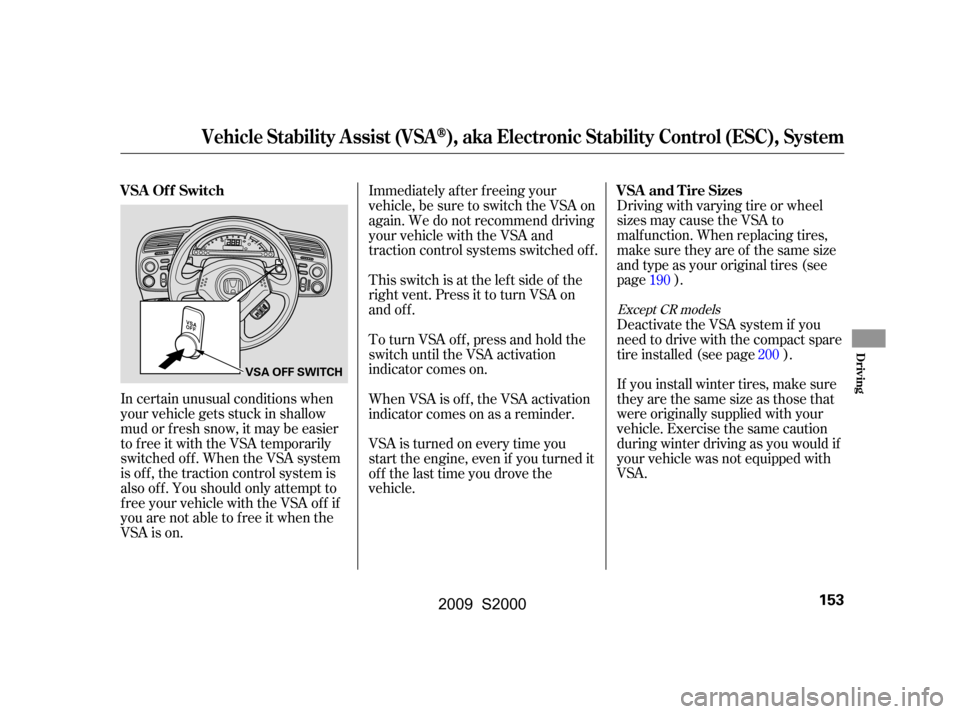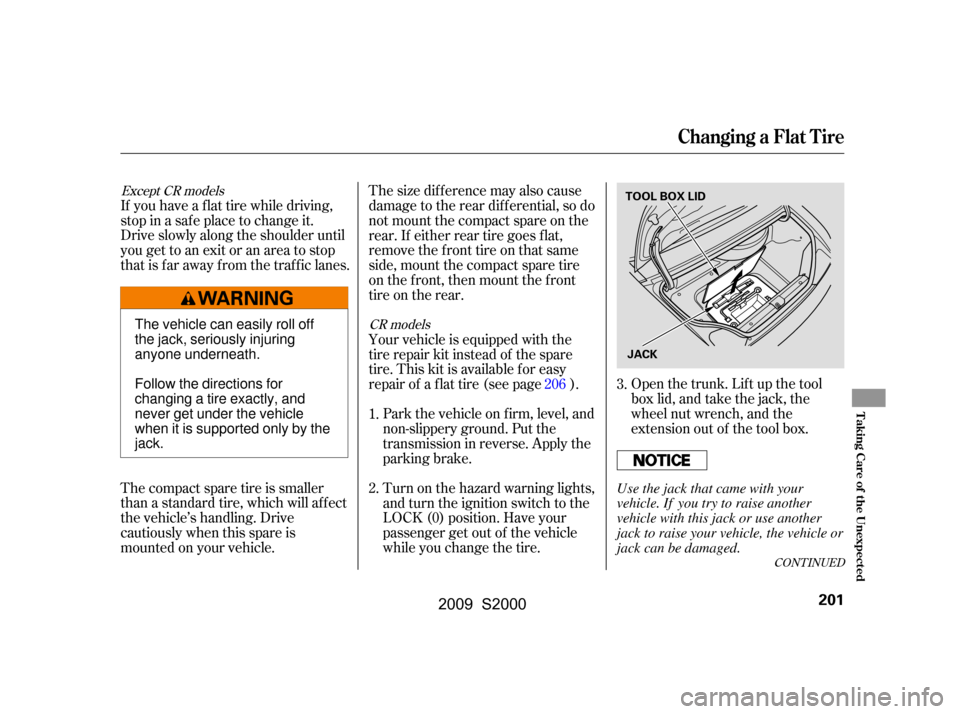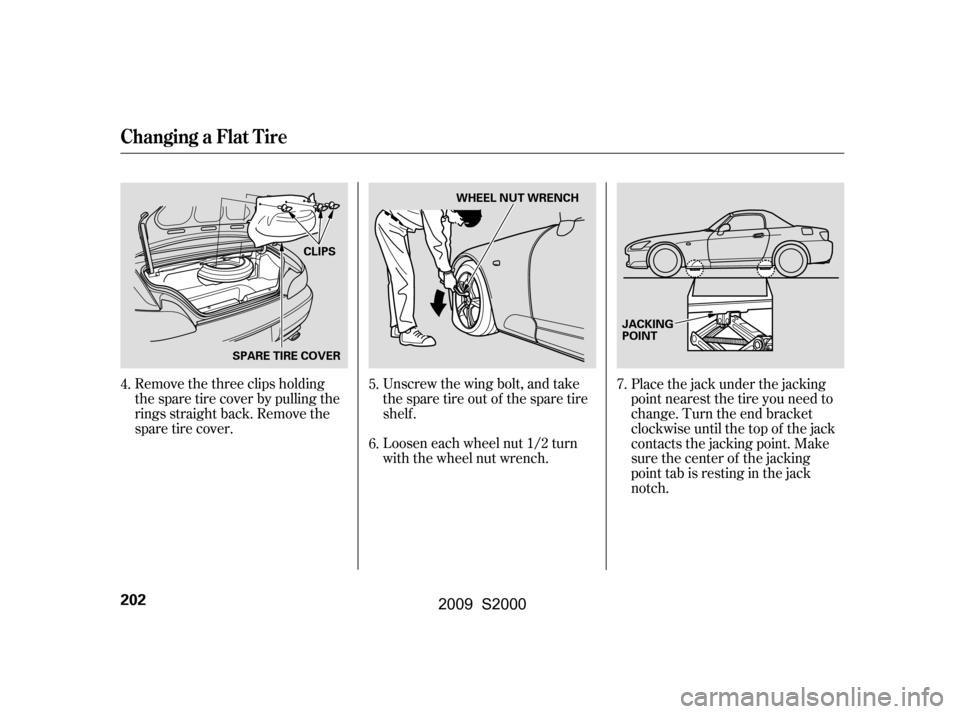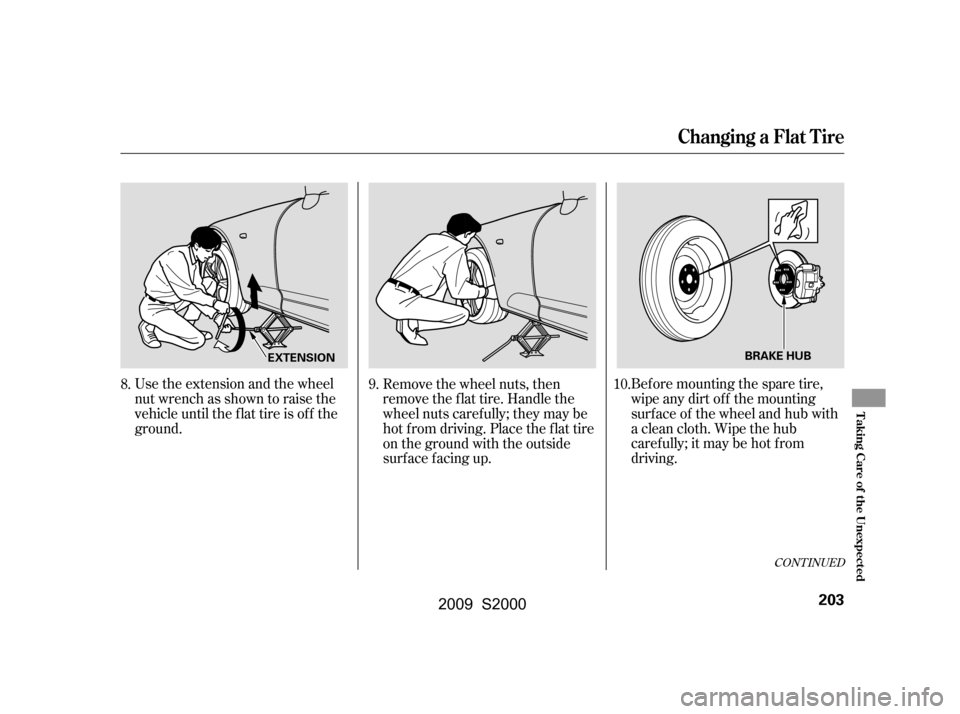2009 HONDA S2000 spare wheel
[x] Cancel search: spare wheelPage 156 of 268

Driving with varying tire or wheel
sizes may cause the VSA to
malf unction. When replacing tires,
make sure they are of the same size
and type as your original tires (see
page ).
In certain unusual conditions when
your vehicle gets stuck in shallow
mud or f resh snow, it may be easier
to free it with the VSA temporarily
switched of f . When the VSA system
is of f , the traction control system is
alsooff.Youshouldonlyattemptto
f ree your vehicle with the VSA of f if
you are not able to f ree it when the
VSA is on. Immediately af ter f reeing your
vehicle, be sure to switch the VSA on
again. We do not recommend driving
your vehicle with the VSA and
traction control systems switched off.
This switch is at the lef t side of the
right vent. Press it to turn VSA on
and off.
If you install winter tires, make sure
they are the same size as those that
were originally supplied with your
vehicle. Exercise the same caution
during winter driving as you would if
your vehicle was not equipped with
VSA.
Deactivate the VSA system if you
need to drive with the compact spare
tire installed (see page ).
To turn VSA of f , press and hold the
switch until the VSA activation
indicator comes on.
When VSA is off, the VSA activation
indicator comes on as a reminder.
VSA is turned on every time you
start the engine, even if you turned it
off the last time you drove the
vehicle. 190
200
Except CR models
VSA Of f Switch VSA and Tire Sizes
Vehicle Stability A ssist (VSA), aka Electronic Stability Control (ESC), System
Driving
153
VSA OFF SWITCH
2009 S2000
Page 158 of 268

For example, if you check and f ill
your tires in a warm area, then drive
in extremely cold weather, the tire
pressure will be lower than
measured and could be underinf lated
and cause the low tire pressure
indicator to come on. Or, if you
check and adjust your tire pressure
in cooler conditions, and drive into
extremely hot conditions, the tire
maybecomeoverinflated.However,
the low tire pressure indicator will
not come on if the tires are
overinf lated.
Refer to page for tire inflation
guidelines.
Although your tire pressure is
monitored, you must manually check
thetirepressuresmonthly.
Each tire, including the spare, should
be checked monthly when cold, and
set to the recommended inf lation
pressure as specif ied on the tireinformation label and in the owner’s
manual (see page ).
This indicator comes on and stays on
if there is a problem with the tire
pressure monitoring system.
If this happens, the system will shut
of f and no longer monitor tire
pressures. Have the system checked
by your dealer as soon as possible.
When you restart the vehicle with
thecompactsparetire,theTPMS
indicator may also come on and stay
on after driving several miles
(kilometers).
If you have a f lat tire, the low tire
pressure indicator will come on.
Replace the flat tire with the
compact spare tire (see page ).
Each wheel (except the compact
sparetirewheel)isequippedwitha
tire pressure sensor mounted inside
the tire behind the valve stem. You
must use TPMS specif ic wheels. It is
recommended that you always have
your tires serviced by your dealer or
qualif ied technician.
189 190
200
Except CR models
Tire Pressure Monitoring System (TPMS)
Tire Pressure Monitoring
System (T PMS) IndicatorChanging a T ire with T PMS
Driving
155
2009 S2000
Page 159 of 268

As required by the FCC:This device complies with Part 15 of theFCC rules. Operation is subject to thef ollowing two conditions: (1) This devicemay not cause harmf ul interf erence, and(2) this device must accept anyinterf erence received, includinginterf erence that may cause undesiredoperation.
Changes or modif ications not expresslyapproved by the party responsible f orcompliance could void the user’sauthority to operate the equipment.
This device complies with IndustryCanada Standard RSS-210.Operation is subject to the f ollowing twoconditions: (1) this device may not causeinterf erence, and (2) this device mustaccept any interf erence that may causeundesired operation of the device.
CR models
If you have a f lat tire, the low tire
pressure indicator will come on.
Repair the f lat tire with the tire
repair kit (see page ).
Each wheel is equipped with a tire
pressure sensor mounted inside the
tire behind the valve stem. You must
use TPMS specif ic wheels. It is
recommended that you always have
your tires serviced by your dealer or
a qualif ied technician.
Af ter you repair the f lat tire, the low
tire pressure indicator may come on.
This is normal; the system is not
monitoring the repaired tire pressure.
Havetheflattirerepairedbythe
dealer as soon as possible.
Never use a puncture-repairing agent
in a f lat tire. If used, you will have to
replace the tire pressure sensor.
Havetheflattirerepairedbyyour
dealer as soon as possible.
After you replace the flat tire with
thecompactsparetire,thelowtire
pressure indicator stays on. This is
normal; the system is not monitoring
the spare tire pressure. Manually
check the spare tire pressure to be
sure it is correct. Af ter several miles
(kilometers) driving with the
compact spare tire, the TPMS
indicator comes on and the low tire
pressure indicator goes of f .
The low tire pressure indicator or
the TPMS indicator will go off, after
several miles (kilometers) driving,
when you replace the spare tire with
the specif ied regular tire equipped
with the tire pressure monitor sensor. 206
Tire Pressure Monitoring System (TPMS)
Repairing a T ire with T PMS
156
2009 S2000
Page 194 of 268

In addition to proper inf lation,
correct wheel alignment helps to
decrease tire wear. If you f ind a tire
is worn unevenly, have your dealer
check the wheel alignment.
Have your dealer check the tires if
you f eel a consistent vibration while
driving. A tire should always be
rebalanced if it is removed f rom the
wheel. When you have new tires
installed, make sure they are
balanced. This increases riding
comf ort and tire lif e. For best results,
have the installer perform a dynamic
balance.
The service lif e of your tires is
dependent on many f actors,
including, but not limited to, driving
habits, road conditions, vehicle
loading, inf lation pressure,
maintenance history, speed, and
environmental conditions (even
when the tires are not in use).
In addition to your regular
inspections and inf lation pressure
maintenance, it is recommended that
you have annual inspections
perf ormed once the tires reach f ive
years old. It is also recommended
that all tires, including the spare, be
removed from service after 10 years
from the date of manufacture,
regardless of their condition or state
of wear.
The last f our digits of the TIN (tire
identif ication number) are f ound on
the sidewall of the tire and indicate
the date of manufacture (See
on page ).238 T ire Maintenance
Tire Service Lif e
Tire
Labeling
Tires
Maint enance
191
Improper wheel weights can damage
your vehicle’s aluminum wheels. Use
only Honda wheel weights f or
balancing.
2009 S2000
Page 203 of 268

Replace the tire when you can see
the tread wear indicator bars. The
replacement should be the same size
and design tire, mounted on the
samewheel.Thesparetireisnot
designed to be mounted on a regular
wheel, and the spare wheel is not
designed f or mounting a regular tire.
Check the inf lation pressure of the
compact spare tire every time you
check the other tires. It should be
inf lated to:
Use the compact spare tire as a
temporary replacement only. Get
your regular tire repaired or replaced,
and put it back on your vehicle as
soon as you can.
Follow these precautions:
Never exceed 50 mph (80 km/h).
This tire gives a harsher ride and
less traction on some road
surf aces. Use greater caution
while driving.
Do not mount tire chains on the
compact spare tire. Do not use your compact spare
tire on another vehicle unless it is
thesamemakeandmodel.
Do not mount the compact spare
tire on either rear wheel position;
it will damage the limited slip
dif f erential (see page ).
The low tire pressure indicator
comes on and stays on af ter you
replace the flat tire with the
compact spare tire. Af ter several
miles (kilometers) driving with the
compact spare tire, the TPMS
indicator comes on and the low
tire pressure indicator goes of f .
201
Except CR models
Compact Spare Tire
200
INDICATOR LOCATION MARK
TREAD WEAR INDICATOR BAR
60 psi (420 kPa , 4.2 kgf/cm)
2009 S2000
Page 204 of 268

Open the trunk. Lift up the tool
box lid, and take the jack, the
wheel nut wrench, and the
extension out of the tool box.
Thecompactsparetireissmaller
than a standard tire, which will affect
the vehicle’s handling. Drive
cautiously when this spare is
mounted on your vehicle.
If you have a f lat tire while driving,
stop in a saf e place to change it.
Drive slowly along the shoulder until
you get to an exit or an area to stop
that is far away from the traffic lanes.
Turn on the hazard warning lights,
and turn the ignition switch to the
LOCK (0) position. Have your
passenger get out of the vehicle
while you change the tire.
Park the vehicle on f irm, level, and
non-slippery ground. Put the
transmission in reverse. Apply the
parking brake.
Thesizedifferencemayalsocause
damage to the rear dif f erential, so do
not mount the compact spare on the
rear. If either rear tire goes f lat,
remove the f ront tire on that same
side, mount the compact spare tire
on the f ront, then mount the f ront
tire on the rear.
Your vehicle is equipped with the
tire repair kit instead of the spare
tire. This kit is available f or easy
repair of a f lat tire (see page ). 3.
1.
2.
206
CONT INUED
Except CR models
CR models
Changing a Flat Tire
T aking Care of t he Unexpect ed
201
TOOL BOX LID
JACK
The vehicle can easily roll off
the jack, seriously injuring
anyone underneath.
Follow the directions for
changing a tire exactly, and
never get under the vehicle
when it is supported only by the
jack. Use the jack that came with your
vehicle. If you try to raise another
vehicle with this jack or use another
jack to raise your vehicle, the vehicle or
jack can be damaged.
2009 S2000
Page 205 of 268

Unscrew the wing bolt, and take
the spare tire out of the spare tire
shelf .
Remove the three clips holding
the spare tire cover by pulling the
rings straight back. Remove the
sparetirecover.
Loosen each wheel nut 1/2 turn
with the wheel nut wrench.Place the jack under the jacking
point nearest the tire you need to
change. Turn the end bracket
clockwise until the top of the jack
contacts the jacking point. Make
sure the center of the jacking
point tab is resting in the jack
notch.
4.
5.
6. 7.
Changing a Flat Tire
202
SPARETIRECOVER WHEEL NUT WRENCH
JACKING
POINT
CLIPS
2009 S2000
Page 206 of 268

Use the extension and the wheel
nut wrench as shown to raise the
vehicle until the f lat tire is of f the
ground.Bef ore mounting the spare tire,
wipeanydirtoff themounting
surface of the wheel and hub with
a clean cloth. Wipe the hub
carefully;itmaybehotfrom
driving.
Remove the wheel nuts, then
removetheflattire.Handlethe
wheel nuts caref ully; they may be
hot from driving. Place the flat tire
on the ground with the outside
surface facing up.
8.
9.10.
CONT INUED
Changing a Flat Tire
T aking Care of t he Unexpect ed
203
BRAKE HUB
EXTENSION
2009 S2000